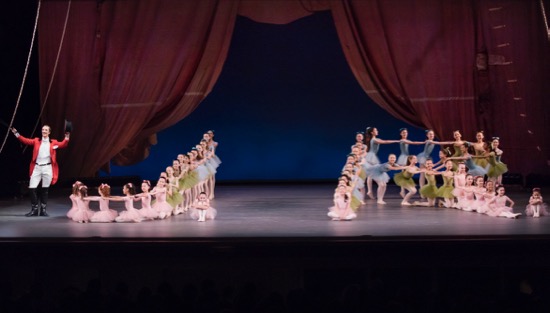
Jerome Robbins’s Circus Polka. Ask la Cour cracks his whip and students of the School of American Ballet lay out Robbins’s initials. Photo: Paul Kolnik
I lived with Jerome Robbins for six years. (Forgive the startling opener; he was dead at the time, but liked a joke). During those years, I read his diaries and his letters, talked with his family, friends, and those he worked with. Since recovering from writing a book about him and his choreography, I haven’t attended many performances of his ballets. Now the New York City Ballet, for which he was a Ballet Master in Chief, is celebrating the 100th anniversary of this remarkable artist’s life, which began in 1918, when he was born in New Jersey as Jerome Rabinowitz.
The Gala NYCB performance that celebrates Robbins made a gallant effort to hint at the ease with which he moved among choreographing ballets, Broadway shows, movies, and television specials. Did I say “ease?” Ironically, while creating a work was a struggle for him, with many versions lying in the dustbin while he sought perfection, ease was what he wanted: difficult steps made to look as if the dancers were just making them up.
Justin Peck called his Spring season premiere Easy in honor of Robbins, although his own life as the company’s current Resident Choreographer may not be uncomplicated (with fellow former NYCB dancers Craig Hall, Rebecca Krohn, and Jonathan Stafford, he is also part of the Interim Artistic Team that was assembled in the wake of Peter Martins’s retirement).
Not very easy was the evening’s opener, Robbins’s The Four Seasons (1974), which followed a very sweet speech by principal dance Maria Kowroski (it was something of a shock when she said that she was the only current company member who had worked with Jerry on a new ballet). The Four Seasons is a big “classical” work, with a different cast for each section. No excerpts from Vivaldi concertos for Robbins. Instead, the music is later and lusher: the third-act ballet from Verdi’s opera I Vespri Siciliani, plus excerpts from the 19th-century composer’s I Lombardo and Il Trovatore.
Robbins was a relentless student of music, playing recordings over and over until the rhythms and melodies and textures became as familiar to him as, say, those of “Happy Birthday.” What he heard in Verdi’s music was also its Romantic atmosphere. The set is an elaborately gilded frame, and each of the four seasons is ushered onto the stage by a commanding leader (Cameron Dieck, Isabella LaFreniere, Clara Frances, and Preston Chamblee), and they, in turn, have been assembled by Silas Farley as the god Janus. What a demonstration of stately demeanor and billowing cloaks!
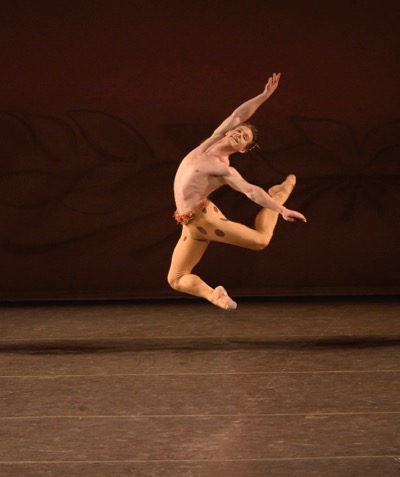
Daniel Ulbricht as the Faun in Robbins’s The Four Seasons. Photo: Paul Kolnik
But Robbins, more or less following Verdi’s original scenario, found ways to amuse the spectators, as well as creating ingenious and demanding classical sequences. The eight women of Winter in their white tutus don’t behave like happy residents of the season. When winter winds Joseph Gordon and Ralph Ippolito cup their hands around their mouths and blow at them, the women clump together, hunch over, and rub their unprotected little arms. Indiana Woodward attaches herself to one shivering cluster (they tend to kick newcomers pertly away), but she’s braver than they are and apparently realizes that tossing off rapid echappés and passés and attracting the guys is a better way to keep warm. You can even briefly see a step that imitates skating on ice, like those in Frederick Ashton’s Les Patineurs.
Spring is the loveliest of the four sections. After the Winter people have been bowed to and wafted away, four men (Daniel Applebaum, Spartak Hoxha, Lars Nielson, and Sebastian Villarini-Velez) enter to attend Sara Mearns, who’s happy to have them looking after her. I hadn’t noticed before how her fine partner, Tyler Angle, his eyes on her, greets her with a single tremendous leap on a musical climax. It makes you think of spring grass fairly bursting out of the earth (as well as of other more human reactions). Mearns dances, as always, wonderfully. I can’t figure out how, when advancing through space, she makes it seem as if her legs begin at her waist; it’s enough to cow the air.
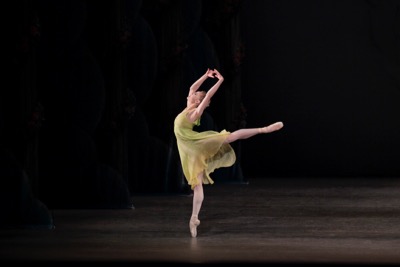
Sara Mearns in the Spring section of Jerome Robbins’s The Four Seasons. Photo: Paul Kolnik
The choreography blends formality and the unexpected in various ways, just the next step isn’t always predictable. The four men of “Winter” line up facing us and—perhaps referencing a similar passage in Marius Petipa’s Raymonda— prepare to show off their jumps. But they don’t go down the line one by one. If my memory served, it’s first one, then another, then two, then all. Your eye pops around to guess who’s next. The orientalist atmosphere that Verdi’s music for “Summer” inspired is a kind of sensual laziness. Its six pink-clad women pulse on almost every step, sinking into it and gently rebounding. Teresa Reichlen and Aaron Sanz are nudged into solos, as if these were pleasant features of a conversation. For “Fall,” Robbins pulls out all the stops. Eight women with their hair down skip like bacchantes and loll about, while a high-jumping faun (Daniel Ulbricht, who else) urges thema on, and marvelous Tyler Peck and Zachary Catazaro revel together and apart (I’m not sure which version of the original pas deux was performed; Robbins devised one for Mikhail Baryshnikov and Patricia McBride and another for Peter Martins and Suzanne Farrell). The end, of course, brings almost everyone onstage for a grand finale.
Igor Stravinsky wrote his “Circus Polka” for a dance that Balanchine was devising for elephants in Ringling Brothers’ Barnum and Bailey Circus. Robbins brought nimbler dancers onstage for the Circus Polka that premiered during the NYCB’s glorious 1972 Stravinsky Festival. He played the Ringmaster, cracking his whip for squads of smaller and smaller girls from the School of American Ballet. He had known ever since 1951, when he choreographed “The March of the Royal Children” for the musical The King and I, how to enchant spectators by playing on the skills of children not trying to be adults. Invariably an audience for the Circus Polka, utters little “aws” of approval when the tiniest squad runs onto the stage. Nice little joke: the tiny one who loses her place. Nice bigger joke: The Ringmaster ( Ask La Cour) repeatedly takes the credit and the bows for what the children have done. In 1972, they formed themselves to spell out “I.S.” In 2018, they arrange themselves into “J.R.”
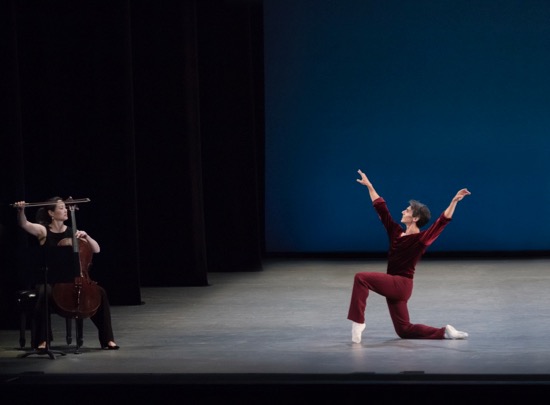
Cellist Ann Kim and Joaquin De Luz in Jerome Robbins’s A Suite of Dances. Photo: Paul Kolnik
Ease as a desirable quality for a dancer to convey is expressed in a solo that Robbins created in 1994 for Baryshnikov to selected movements from J.S. Bach’s Six Suites for Solo Cello. Juxtaposing of one of the world’s most virtuosic dancers with an onstage cellist playing a great composer’s work—and then endeavoring to make a ballet that looked as if it were being dreamed up on the spot—was an endeavor that only Robbins would have attempted. Joaquin De Luz, seated on the floor, watches Ann Kim begin to play. How easily, how slowly he works his way into Bach’s music! He never stops listening to it and investigating how his body might respond, what his arm alone might do. You sense the two artists onstage communicating about what they want to try next. The build into difficult steps is almost unnoticeable. Near the end, De Luz starts repeatedly traveling toward the audience, then backing up and trying a different style or steps. All in all, a triumph for him.
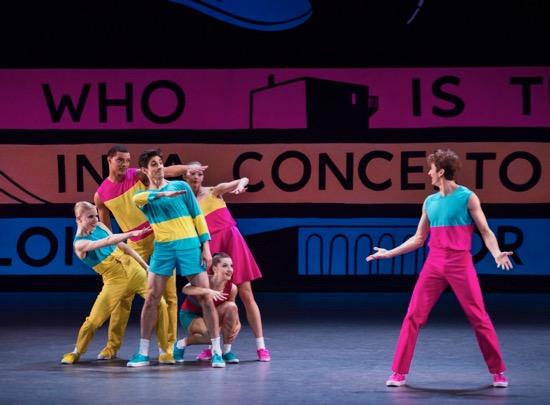
Justin Peck’s Easy. (L to R): Claire Kretzschmer, Preston Chamblee, Sean Suozzi, Indiana Woodward (crouching) , Unity Phelan, and Harrison Coll. Photo: Paul Kolnik
Peck’s Easy, colludes with Robbins’s collaboration with Leonard Bernstein on West Side Story. I think of it in relation to “Cool,” one of the musical’s songs: “Boy, boy, crazy boy,/ Stay loose, boy./ Breeze it, buzz it,/ Easy does it,/Turn off the juice, boy.” The music for Easy is Bernstein’s jazzy Prelude, Fugue and Riffs (arranged for orchestra, with Steven Hartman as its solo clarinetist), nor is there any hint of gang warfare and repressed violence. No plot either. There’s just a sense of teenagers at play, maybe on city streets or in schoolyard. Who wants to be with whom? Who’d like to join some good-looking dancing? Stephen Powers’s puzzling backdrop shows two pairs of legs in sneakers, with terms like “easy peasy” and “hurly burly’ posted on them and big black sentences, one of which asks who’s the soloist in a concerto.
The six engaging dancers—Preston Chamblee, Harrison Coll, Claire Kretzschmar, Unity Phelan, Sean Suozzi, and Indiana Woodward—are costumed individually and vividly by Reid Bartelme and Harriet Jung. They form alliances casually. Maybe the men take turns lifting one another. Maybe two women dance the same steps. The atmosphere is, well, easy; the dancers come and go or stay and watch one another. And the dancing is easygoing. Sneakers rather than pointe shoes, feet often flexed or relaxed, some steps low to the ground. At times, too, there’s a looseness to the movement, so it looks like spontaneous behavior. The ballet ends with a familiar joke. Coll is left along onstage, wondering “where’d they all go?” Spotting them offstage, he rushes for the wings, hurls himself into the air, and is caught by their invisible hands.
Easy is a homage to the Robbins-Bernstein collaboration. It isn’t, to my mind, one of the hugely gifted Peck’s best works, but its appropriateness and the dancers’ verve and commitment elevate it.
The also new Something to Dance About is another sort of homage—this one celebrating Robbins’s Broadway career. All the choreography is supposedly his, but the direction and staging are by Warren Carlyle, a choreographer noted for his work on Broadway and television. The project, splendidly lit by Mark Stanley, is hugely ambitious. The music by Bernstein, Jule Styne, Richard Rodgers, and Jerry Bock has been arranged by Rob Berman and orchestrated by Jonathan Tunick. Ten featured dancers (nine of them principals), plus ten men and ten women, many with multiple costume changes. Carlyle has duplicated Robbins’s choreography where possible, created transitions, and filled in gaps—weaving in, overlapping, and briefly layering material from seven different shows: On the Town, Gypsy, West Side Story, The King and I, Billion Dollar Baby, Funny Girl, and Fiddler on the Roof. The expert singer, Jessica Vosk, delivers some of the songs, while moving close to the dancers and seeming to cajole them or egg them on.
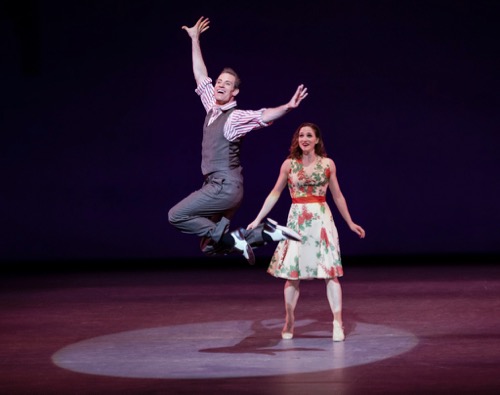
Ashley Bouder and Andrew Veyette in a scene from Gypsy in Something to Dance About—a medley of Jerome Robbins’s choreography, directed and staged by Warren Carlyle. Photo: Paul Kolnik
Sometimes you get a tangy taste of the original numbers—say, three male and three female principal dancers kiting around, as a small horde of On the Town’s sailors accumulates. Or a quick taste of West Side Story’s “Dance at the Gym,” the skirts of the women’s red dresses (by Toni-Leslie James) flaring. These partygoers frame Lauren Lovette and De Luz, slowly approaching each other as Maria and Tony, before those two yield to another pair: Peck in a bouffant gown polkaing with Taylor Stanley and other couples in “Shall We Dance” from The King and I. Other excerpts slide by before you’re sure what they are: for instance, Mearns and Woodward in Siamese attire, as, I presume, Eliza and the Angel, walking over the strip of blue cloth representing ice in the The King and I’s “Small House of Uncle Thomas” Or Peck and Ulbrecht briefly leading a Charleston from Billion Dollar Baby.
Gaudiness is balanced by simplicity. Andrew Veyette and Ashley Bouder mostly chat in “All I need is the Girl” from Gypsy. Four men in black give us a glimpse of the slow, squatting-down “Wedding Dance” from Fiddler on the Roof. As a whole, Something to Dance About is both stunning and confusing. I’m glad that the superb dancers of the New York City Ballet, many of whom couldn’t have seen all the shows that Robbins choreographed, got a taste of them in their own bodies.
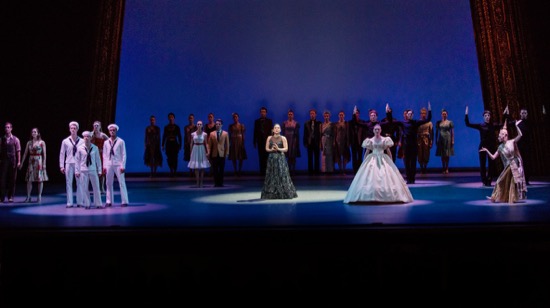
Something to Dance About, the final image. In the light (L to R): Andrew Veyette and Ashley Bouder; Chase Finley, Daniel Ulbricht, and Taylor Stanley, with Sara Mearns behind them; Lauren Lovette and Joaquin De Luz; Jessica Vosk; Tyler Peck; Indiana Woodward; and, just behind these last, four male dancers from Fiddler on the Roof. Photo: Paul Kolnik
The ending brought tears to my eyes. The cast assembles onstage, costumed for all the works, and, as a photograph on Robbins’s smiling face appears in the proscenium arch projected on the backdrop, Vosk sings another song from The King and I: Lady Chiang’s words to Anna about the king she’s serving:
“He will not always say what you would have him say
But, now and then he’ll say something wonderful.
The thoughtless things he’ll do will hurt and worry you,
Then, all at once he’ll do something wonderful.”
Indeed. Happy 100th Jerry. Wish you’d been here.

And I wish I had been there, too. Lovely words about what was clearly a lovely evening. Thank you Deborah for taking us with you.
Dear “Professor” Jowitt. I have enjoyed reading your essays for many years. Ever since you were my dance
critique writing professor at NYU Tisch School of the Arts MFA program. By the way, i received an “A” 🙂 Is there an available volume of your writings published that i may purchase ? I truly consider you a national treasure (along with Professor Sergio Cervetti). God Bless you.
Dear “Professor” Jowitt. I have enjoyed reading your essays for many years. Ever since you were my dance critique writing professor at NYU Tisch School of the Arts MFA program. By the way, i received an “A” 🙂 I truly consider you a national treasure (along with Professor Sergio Cervetti). God Bless you.